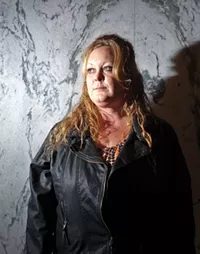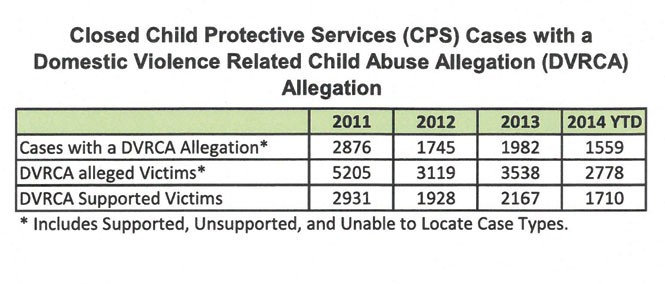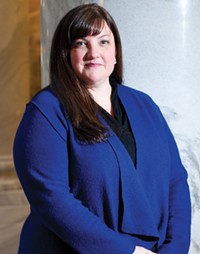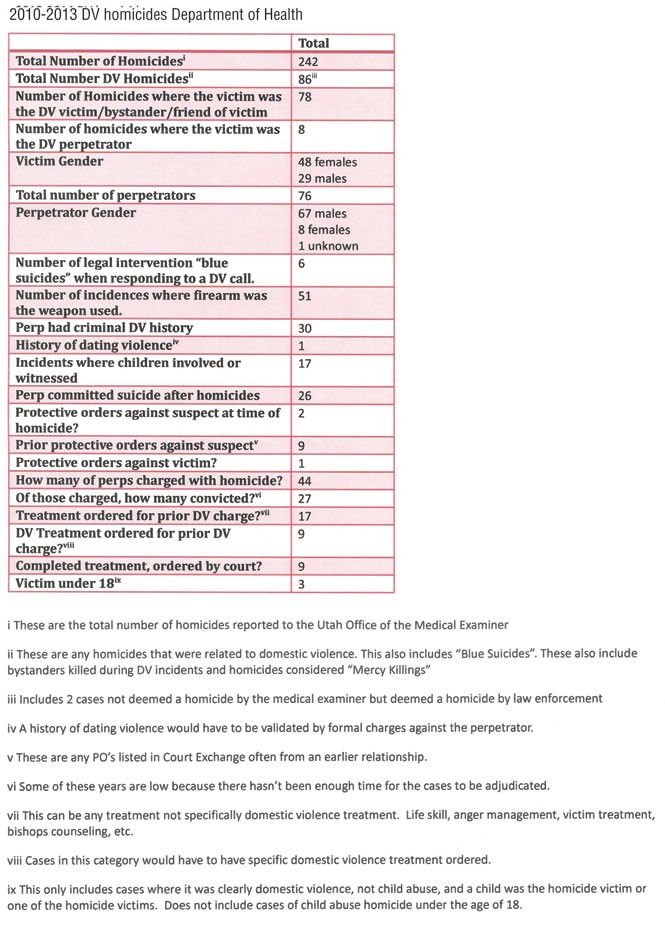Powerless
While state funds for domestic violence dwindle, the cost in lives climbs
By Stephen Dark @stephenpdarkFive years into their marriage, Debbie Mayo found out that her husband, Chad, had been having an affair. In the wake of the revelation, her young husband—they'd married as teenagers—became "an angry, crying mess," Mayo says, though before that moment, she'd seen him cry only twice.
At first, she says, her "heart just wrenched," but his tears soon escalated to threats of suicide, and then violence.
He grabbed her arms so hard he left bruises before throwing her on the bed, gripping her face in his hand and squeezing as she screamed.
On Feb. 9, 1998, he went to their West Jordan apartment and asked her to take him back. When she refused, he pulled a gun from his waistband and told her to call the police. She stayed with Chad as a SWAT team deployed outside, finally leaving after he told her he would follow in five minutes. Shortly after, the 22-year-old shot himself in the head.
Domestic violence rears its head rarely in the public arena, perhaps when a NFL football player knocks out his wife in an elevator, or a Spanish Fork policeman kills his family and himself.
But domestic violence is a quiet plague in Utah. Between 2009 and 2011, more people were killed in domestic-violence-related issues than other types of homicides. According to 2010 figures from the Centers for Disease Control & Prevention, one in three Utah women will face rape, physical violence and/or stalking by an intimate partner in their lifetime, and once every 33 days, on average, there is one death related to intimate-partner violence.
These deaths are often the culmination of long-time violence that, in many cases, goes unreported.
When it is reported, victims face a fractured, overburdened system made up of law enforcement, shelters, justice courts and treatment providers. And advocates say that anyone who looks at this system will see that change is sorely needed.
Police officers need more training, and shelters are always full; last year they served as many people, approximately 3,000, as they turned away. The courts struggle to hold perpetrators accountable—a process partially undermined, some say, by the ineffectiveness of offender treatment, which neither is standardized nor has much oversight.
Mayo is intimately familiar with the nature of domestic violence and its far-reaching consequences. Her next long-term relationship after Chad's death was verbally abusive. "I've always been better at helping other people than helping myself," says Mayo, who now runs a domestic-violence shelter in Richfield and is the chairwoman of the Utah Domestic Violence Coalition board, which represents the interests of shelters.
Mayo's shelter, called New Horizons Crisis Center, serves five counties, an area of 13,581 square miles, with a full-time staff of seven, five part-timers, and volunteers.
Since October 2010, there have been seven domestic-violence-related homicides in Sevier County and Sanpete County alone, two of which were murder-suicides. Mayo can recall only one prior to that.
And the growing demand for New Horizons' services has outstripped its resources. In 2014, for the first time, the shelter had to turn people away because it was full.
New Horizons serves just a small slice of the state's population, but its experiences are a microcosm of a much wider trend: Domestic violence in Utah is escalating, and outpacing the funds and support available to its victims, which has only decreased in recent years.
According to documents obtained by City Weekly through a records request, the Division of Child & Family Services in 2014 had a domestic-violence budget of $2.21 million, down from $3.53 million in 2011.
Yet 2014 saw a five-year peak in domestic-violence-related deaths, with, according to provisional figures from the Department of Health, 29 women, men and children losing their lives to domestic violence.
YOU'RE IN DANGER
On a cold, windy Monday night in late December, West Valley City Police Department Detective Justin Boardman races in an unmarked car to a "domestic," to show a City Weekly reporter the realities of police encounters with domestic-violence scenes. Utah defines domestic violence as both intimate-partner violence and cohabitant violence between, for example, a father and a son.
As darkness falls, domestic-violence calls to dispatch pop up repeatedly on Boardman's police computer. He stops at one family-related domestic-violence call, and another—for the apartment building behind it—appears on the on-call screen. "That's more like the West Valley I know," he says cheerily.
On one poorly lit street with a reputation for drug crimes and shootings, officers have been called to a protective-order violation. A 26-year-old man has refused to leave the apartment of his 22-year-old ex-girlfriend, who got the protective order against him earlier that day. She's also nine months pregnant with his child.
The man had entered her apartment with his current girlfriend and refused to leave. After he verbally abused his ex, she and her 2-year-old daughter—also his child—went and sat in her car, and she called the police.
The police remove the man and his girlfriend. An officer tells the ex-girlfriend that she has to go to court Jan. 6, 2015, to make the protective order permanent, but she says she plans to drop it.
Once the immediate crisis has passed, "unfortunately, the majority of our victims recant, they want it to go away, they want it dismissed," says Rachelle Hill, victim advocate at West Valley City Police Department, which sees 4,000 domestic-violence crimes a year. "And I don't necessarily blame them. As an advocate, I can't really promise them it's going to get better. I can probably promise them it will get worse."
While the court system keeps fines minimal for offenders, victims find themselves having to work multiple jobs to pay their partner's court fines or bail money. "They either stay with the abuser or try to do it on their own," Hill says. "Ideally, we want them to become self-sustaining, but starting-level jobs pay so little. Rent, gas, day care [costs] just shadows that paycheck, and eats it up so quickly."
But for Boardman, the key moment is when law enforcement first encounters a domestic-violence victim such as the 22-year-old. A lethality assessment—a series of weighted questions—can play a key role in helping a victim understand how dangerous her situation is, he says, and perhaps save a life.
In 2005, Maryland instituted a lethality-assessment protocol that's been credited with reducing domestic-violence homicide rates within that state by 40 percent, says Woods Cross Police Chief Greg Butler, whose officers currently are the only ones in Utah trained and certified in the protocol. Thirty states have adopted the model.
Download Lethality Assessment FormButler says the protocol saved a woman's life shortly after his men were trained. "We need to get it implemented in the state of Utah," he says.
The woman, whom Butler declined to identify, was a recent divorcee who told her LDS bishop she suspected her ex-husband was abusing their children. The bishop contacted Child Protective Services, which contacted the Woods Cross Police Department. Detectives discovered that the woman's ex-husband, a former Marine combat medic, had been stalking her, and had broken into her house, made her bed and left a condom on it. When a detective reviewed the lethality assessment form with her, Butler says, "a light bulb came on" as she realized how much danger she was in, and moved with her children to a friend's house.
Officers subsequently cornered her ex-husband, who had been digging holes in various places, as if "looking for a place to dispose of her body," Butler says. He killed himself with his own handgun.
While West Valley officers have a domestic-violence questionnaire to fill out, WVCPD does not currently utilize the Maryland assessment, though Boardman is hopeful that his department will take it onboard.
Download West Valley Police DV QuestionaireIn contrast to situations where, Boardman says, a cop's gut says the victim could be killed, the lethality assessment would allow a cop to show a victim she has scored high, and then follow the protocol and call the shelter WVCPD works with—South Valley Sanctuary—so the victim can make contact with a shelter worker.
Still, Hill says, "less than 10 percent of clients we serve want to go to shelter."
And, "that being said, that small handful can't get in," she says.
MONEY FOR SOME
While there are preventative measures like the lethality assessment, the upcoming legislative session is a reminder that shelters will have to line up along with everyone else to seek funds from the Social Services Appropriation subcommittee.
Sen. Todd Weiler, R-Woods Cross, is a relative newcomer to the subcommittee, at just three years on the Hill. But, come the 2015 legislative session, Weiler and the 16 other members of the subcommittee will have to perform Solomon-like acts of judgment, as they are faced by "a barrage of requests from across the spectrum," he says.
He's visited the Davis County shelter, Safe Harbor. "I know they feel like they are in desperate need of additional funding," he says. But he also cites mothers with autistic children as a group that has got his attention, and compares the committee to being on a lifeboat with six children and having only one life vest.
"You have to decide which child you're going to save," he says.
Utah's 13 nonprofit domestic-violence shelters split just over $1 million annually from DCFS and $1 million in federal grants administered by the state, along with an additional $800,000-plus in federal funding. Beyond that, they rely on whatever ongoing and one-time monies they can beg from the Social Services Appropriation subcommittee.
Download DV Shelters State Federal IncomeIn January 2014, they got $300,000 in ongoing funding and $393,500 in one-time funding, split 13 ways. And advocates say it's not enough for the shelters, which are facing rapidly increasing demand.
Over the past five years, Utah's shelters increased by 40 percent the total annual number of nights of shelter they provided, but that was still outstripped by unmet need, which climbed 67 percent.
And while demand for services has increased, DCFS, charged with protecting the welfare of children and families, has cut back its front-line involvement in providing domestic-violence services.
DCFS typically becomes involved in domestic-violence through allegations of domestic-violence-related child abuse [DVRCA] made to Child Protective Services. Several years ago, in the face of legislative concerns over families' civil rights being trodden on, the criteria for triggering those investigations were tightened.
This led to a substantial reduction in the number of DCFS domestic-violence case investigations, from 2,876 in 2011 to 1,982 in 2013, according to a City Weekly records request.
State funding for domestic-violence services has also declined. A record request to DCFS revealed that its domestic-violence budget went from $3.53 million in 2011 to $2.21 million in 2014.
What that has meant for shelters is greater pressure on their resources. In 2012, Mayo wrote in a recent grant application, DCFS cut regional domestic-violence positions, pushing up the number of referrals to the shelter and putting further strain on her already overburdened staff.
The number of DCFS domestic-violence positions has gone from 56 in 2011 to 29 in 2014, through a mix of attrition and reassignments, according to a City Weekly records request to DCFS.
Download DCFS Stats for specialists positions.And domestic-violence workers in DCFS' southwest Utah region, where New Horizons is located, had their job duties expanded, adding a focus on kinship placement and foster care to their domestic violence priorities.
"They're still on the domestic-violence budget, but they're not doing domestic violence specifically," says Jenn Oxborrow, who has been administrator of domestic-violence services at the Utah Division of Child & Family Services for 18 months. "The way we are using our funding and programming is inefficient and ineffective."
DCFS director Brent Platt says he has to manage a $167 million budget, so the domestic-violence budget doesn't necessarily register on his radar. DCFS records show that the reduction in domestic-violence specialists employed by DCFS across the state is the main cause for the decline.
But DCFS' budget, despite the tightening, does carry a surplus. In 2011, that surplus was $735,207; in 2014, it was $455,323, part of it reflecting budgeted monies not spent on treatment providers, part of it budgeted funds not spent on specialist state DV workers.
Mayo looks over the figures and winces. The surpluses are a potential lifeline she can't understand not being made available to shelters. "I could do a lot with that surplus," she says.
Download DCFS DV Services Budget 2011-14She refers to the nondescript New Horizons shelter, a former nursing home, as the "bat cave." The electronic front gate that bars access to the hostel is permanently broken, she says. Shelter workers have to wheel it shut by hand.
In the front lobby, two boys energetically chase each other with NERF guns, while a girl kicks a soccer ball along a corridor. One employee recently jazzed up the communal bathroom and showers with splashes of bright pink, and affixed decals to the wall—high heeled shoes, a big lipstick, a purse—along with signs that say, "Dry those tears," "Put on your lipstick," and "Everything will be OK."
After Christmas, workers found several dozen garbage bags of clothes for the shelter. But donations, Mayo says, are never a problem. It's money she needs. It costs $25,000 annually to maintain the shelter. There's no yardmen, housekeeping or maids, she notes. The all-female staff do what they can, she says. "A hole in the wall, we fix it—a bunch of chicks and YouTube."
NO MORE ROOM AT THE INN
Gloria Arredondo is a domestic-violence survivor whose ex-husband, over a period of 14 years, "took away the individual part of me," she says. "I became a mother and wife; there was nothing left of me."
Arredondo, a member of The Church of Jesus Christ of Latter-day Saints, says even her testimony was fair game for her former partner. "My testimonies were too long, too dramatic. Everything about me started to bother him."
When she looked into the mirror, she saw a monster, she says. "But it was him; it was his reflection."
She broke away from his psychological abuse and now lives in her parents' basement with her children, writing erotic poetry and books on how to survive domestic-violence and working with women trying to leave abusers.
Arredondo says the women she works with, many of whom are Latina, encounter numerous barriers to accessing service. These include a lack of access to bank accounts or independent sources of income; religious issues (Mormon women "have this concept of eternal marriage which sometimes stops people from leaving," she says); language—shelters often don't have full-time Spanish speakers—no driver's license or other identification; and for some, a sense of being "inhuman, because they are illegal," she says. "There's a giant fear of being deported." She says she's known women who "have tried to jump off the roof, taken pills, cut themselves," because they can't find another way to leave their abuser.
One morning, Arredondo says, she took a woman to the YWCA after the woman called her saying she would kill herself rather than stay with her abusive spouse. The Y was full, so they called three other shelters. They were full, too. Finally, one said they could take her, but only for a day.
"What do you do in a day?" Arredondo asks. "If you've escaped, you've already made him mad." She took the woman to her home, fed her, then was told by a shelter to drop her off at a different location.
The next day, when Arredondo went to pick her up for an appointment with a lawyer, she found that the woman had used the money Arredondo had given her for breakfast to get a taxi home.
AN ISSUE OF TRUST
Utah's shelters historically have received state money through a formula that gives greater funding to shelters that provide a greater number of nights of shelter.
Jenn Campbell runs South Valley Sanctuary, a shelter hidden behind a fence in the southern end of the valley. "We try to make it as homely as possible," Campbell says, opening the door to a boutique where survivors can acquire "gently used" donated clothing.
"The hard component is our practice doesn't fit the model that [the shelter-night formula] is trying to serve," Campbell says. "We are dealing with trust and safety. It isn't about putting families in rooms."
While providing shelter from domestic violence is important, she says, the key is building trust with victims. This means South Valley provides an array of support services, whether it be counseling, working with attorneys to get protective orders or a myriad of other needs victims have as they try to safely untangle their lives from their abusers.
When a City Weekly reporter visited South Valley Sanctuary, the shelter was full. Campbell says there were 40 people staying there, 20 to 25 of whom were children. On average, the shelter turns away 600 to 700 individuals each year.
Echoing other shelter directors, Campbell says South Valley simply doesn't have sufficient financial resources for their needs. "This is basic need. I don't know we can present it any better."
Campbell feels that aspects of the shelter-night formula "almost penalize" shelters, though, she says, "we all try to serve victims in a way that's victim-centered."
Across the valley, a few days later, the YWCA in downtown Salt Lake City was also full. In 2013, the Y turned away 1,200 people. The day a City Weekly reporter visited, there were 227 people staying on the campus, 156 of whom were children.
Keri Jones, chief program officer at the YWCA, notes that while domestic-violence services grew out of providing shelter, "I dare say if you ask the majority of victims, they don't want to leave home. They just want the abuse to stop."
The DCFS' Oxborrow says the shelter-night funding formula was an attempt to organize and equalize funding. She is set to change that formula, she says, to a yet-to-be-decided new approach.
DV DEJA-VU
From 2010 through the end of 2013, according to statistics City Weekly requested from the Department of Health, 30 of the 67 men and eight women responsible for a total of 86 domestic-violence-related homicides in Utah had prior criminal charges for domestic violence.
Of the 30 killers, just 17 had been ordered to treatment, though it is mandatory under state statute that offenders convicted of domestic violence—a misdemeanor—receive treatment.
But the statute does not codify exactly what that treatment should be. Of the 17 ordered to treatment, nine were ordered to domestic-violence treatment, while the remaining eight were given bishop counseling or life-skills and anger-management courses. Only nine of the 17 completed their treatment.
Judge John Baxter of the Salt Lake City justice courts says that while under active judicial supervision, a domestic-violence defendant "seems a little more compliant in recidivism and the victim feels a little bit safer."
But, he continues, "there's been no studies so far that have shown a lasting effect on the perpetrator."
Judge Rick Romney has a dedicated domestic-violence calendar in his Provo Justice Court. His hope, he says, is that his court will act as a "homicide-prevention business," using evaluation by a DCFS-appointed evaluator and treatment by a DCFS-regulated treatment provider to help people acquire better skill sets.
Baxter had a similarly formalized domestic-violence court for nine years but ended it partly because of a lack of funding and partly because he felt it had little impact. The presence of watchful judges seemed to do little to change perpetrators in the long run. And, he says, "the treatment models at this point don't seem to do much."
A Utah statute that dictates a minimum of 16 weeks of sessions for domestic-violence treatment meets no one's needs, he argues. "If a person really needed batterer intervention, 16 sessions wasn't going to get anywhere near what was necessary," Baxter says. "And if he didn't need it, 16 was too much to sit in sessions with batterers learning things an individual didn't need to learn."
Judges feel caught, Baxter says. There's no way of predicting how someone appearing before him for a class B misdemeanor involving a punch or slap might go on to murder someone, he says. "We want it to end; we know treatment available to this point doesn't seem to be particularly effective, yet we're reluctant to do nothing," he says. "We'd really like treatment professionals or academics to end domestic violence. Maybe that's hoping for the moon; I hope not."
BEHIND CLOSED DOORS
There are 94 licensed treatment providers in Utah, but only 19 contract with DCFS. In order to contract with the state, a provider has to meet certain regulations. Oxborrow says she's overhauled the contract language and has "extensive plans to bring in high-quality training along with the increasing expectation that they will use evidence-based programs."
But that leaves the bulk of treatment providers either licensed by Division of Professional Licensing and DHS Office of Licensing, or only by DOPL. They can set their fees at any rates, can tell the court no intervention is required, and are not subject to their programming or the outcomes of their treatment being monitored.
City Weekly requested interviews with five treatment providers, both agencies and independent therapists, through phone calls and e-mails, but none responded.
The Utah Association for Domestic Violent Treatment, formed in 2012, seeks to represent treatment providers. One of its founders, Isaac Phillips, a licensed clinical social worker, recalls holding a meeting with 17 agencies in domestic-violence treatment to talk about what a court-ordered evaluation process of an offender should look like. "We had 17 quite different approaches," he says.
And there are several large, well-known agencies that, he says, have never attended a conference or meetings of UADVT or the Utah Domestic Violence Coalition in his eight years.
"What are they doing behind their doors? That's the scary thing," he says, noting that this is strictly his opinion. "What we know as best practices, there's little holding them to do that in their agencies. If people want to make big money, the system, due to its looseness, allows for that."
Some methods of treatment, shelter advocates say, can aggravate situations. "What I notice is people mention, 'My abuser did the treatment, did the classes, he stopped hitting, but the psychological abuse is getting worse,'" says South Valley case manager Stella Soler. Abusers learn from other abusers in groups what works in terms of avoiding more jail time while keeping control over their victim, she says.
In total, according to a City Weekly record request to DCFS, the state spends approximately $1.2 million annually for adult offenders, child services and survivors to get treatment. But because the system is highly complex, only Utah's courts typically access contracts, resulting in the bulk of the money going to help pay for offender treatment.
Oxborrow believes Utah is the only state using mandatory criminal fees paid by offenders to financially offset criminal services for domestic-violence offenders. DCFS' domestic-violence treatment budget is "dedicated to serve families, but by and large, it's used by offenders."
Children get neglected, says Jones, whose background is in working with children caught up in domestic violence. "I tell my staff that if they do nothing else, make the child feel safe and secure and help them identify their own emotions," she says. "Serve them, rather than send all these wounded little humans into the universe with no idea how to contain their own rage, which they're going to exhibit one day on someone else."
According to state figures, 80 children will find their mother dead or see domestic-violence in Utah each year, but only 60 percent will receive therapy, and those often only once.
"I don't understand why our community doesn't want to focus more on our own children," Jones says.
STANDING ALONE
Oxborrow hopes to rebuild DCFS' regional DV specialist network and have a domestic-violence specialist assigned in each region by the summer. She's also pushed for a detailed assessment of domestic violence in Utah. "To help us get to a meaningful system of care, we need a data-driven needs assessment."
It's taken a year, but finally, a contract for an independent assessment team is about to be inked, she says.
Oxborrow also met with Sen. Allen Christensen, R-North Ogden, in late 2014 about securing funding of $750,000 for lethality-assessment personnel for all the shelters. He says he will run a bill to promote this approach, or possibly seek an appropriation.
But while describing it as a "very worthwhile program," he says he's already been told "there isn't any money for new programs this year." He adds that he will also be pushing for the shelters' one-time funding of $393,500 from the last session to be made ongoing, making the total request by victim-service-providers for the 2016 fiscal year $1.1 million.
For the past two years, DCFS has made a financial request for the shelters on their behalf. But while Oxborrow remains a passionate advocate for the shelters that contract with her, her boss Brent Platt declined to have DCFS ask on behalf of shelters this time around. He will be their biggest cheerleader, he says, but has to focus on internal budget issues and "child-welfare issues." The shelters "need to be their own force to be recognized with," he says.
The governor's proposed budget for this session does not include any recommendations for money for the shelters, "so it's going to be tough," Oxborrow says.
But New Horizons and other organizations that give support to victims, Mayo says, offer "people empowerment to help their lives."
Providing shelter, she says, can be "life-saving. It's sometimes the only place people have to go. And their lives matter."
More by Stephen Dark
-
Call it a Comeback
Long mired in economic depression, Midvale’s Main Street dusts off its small-town charm.
- Sep 20, 2017
-
Love Letters
Correspondence between a young woman at the Topaz internment camp and her beloved sheds light on Trump's America.
- Sep 6, 2017
-
Triggered
Veterans Affairs exists to help vets. So why did the Salt Lake VA appoint an anti-veteran chief?
- Aug 30, 2017
- More »
Latest in Cover Story
Readers also liked…
-
Forget the family pedigree—Robert F. Kennedy Jr should not be the next president of the United States
Trojan Horse
- Jun 21, 2023
-
Women decry harassment and toxic culture at St. George auto dealership
Men at Work
- Oct 11, 2023











